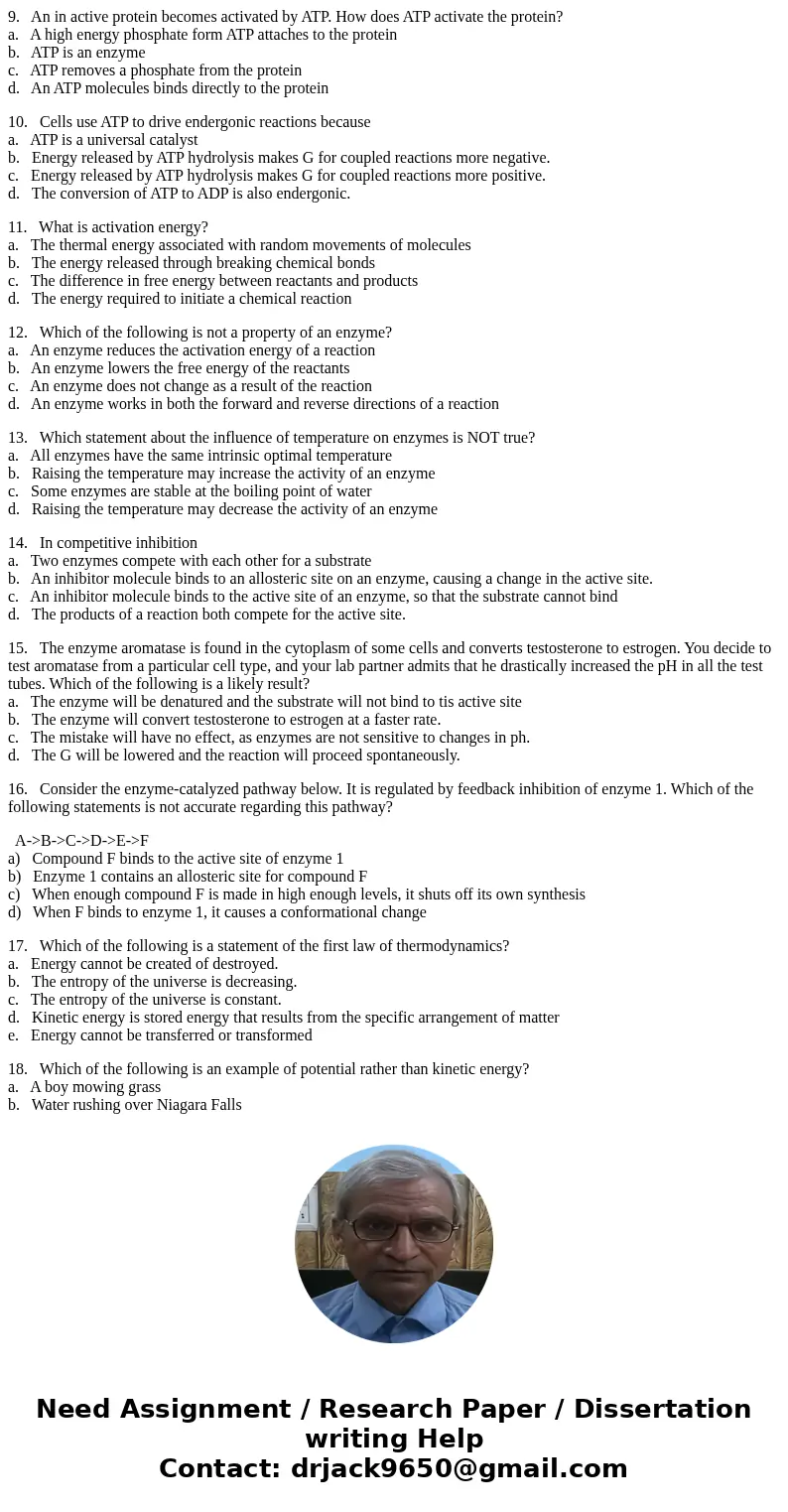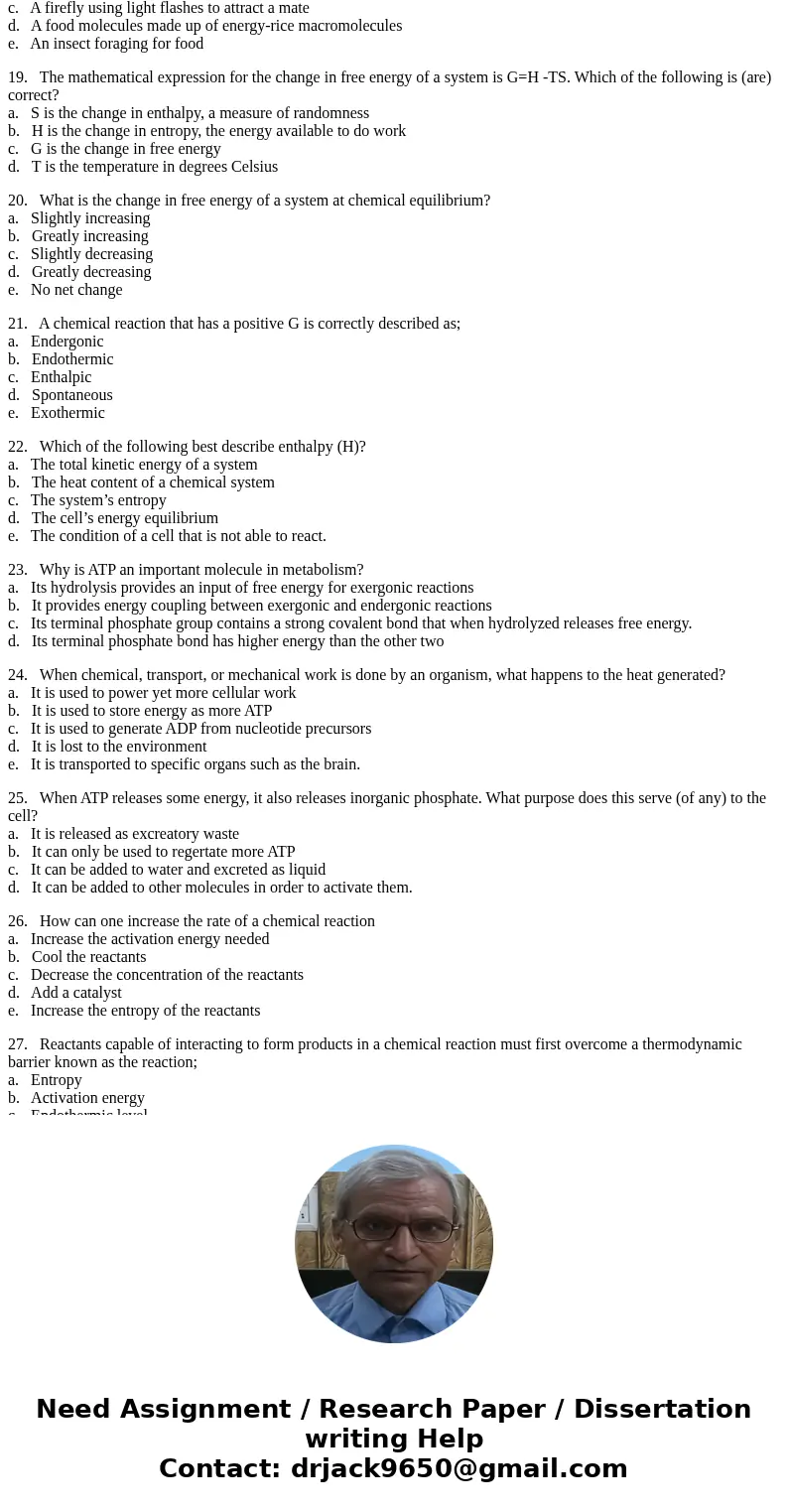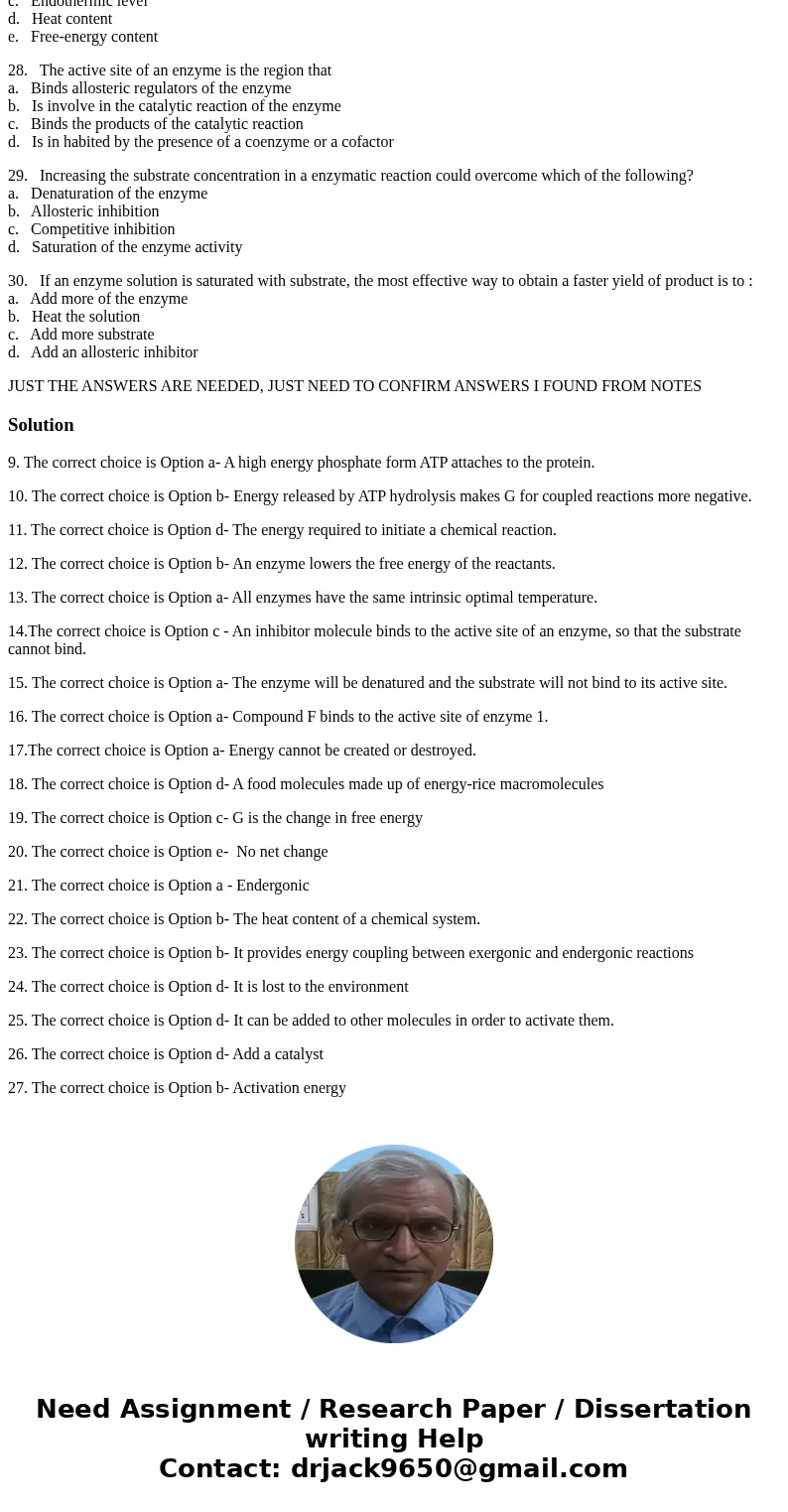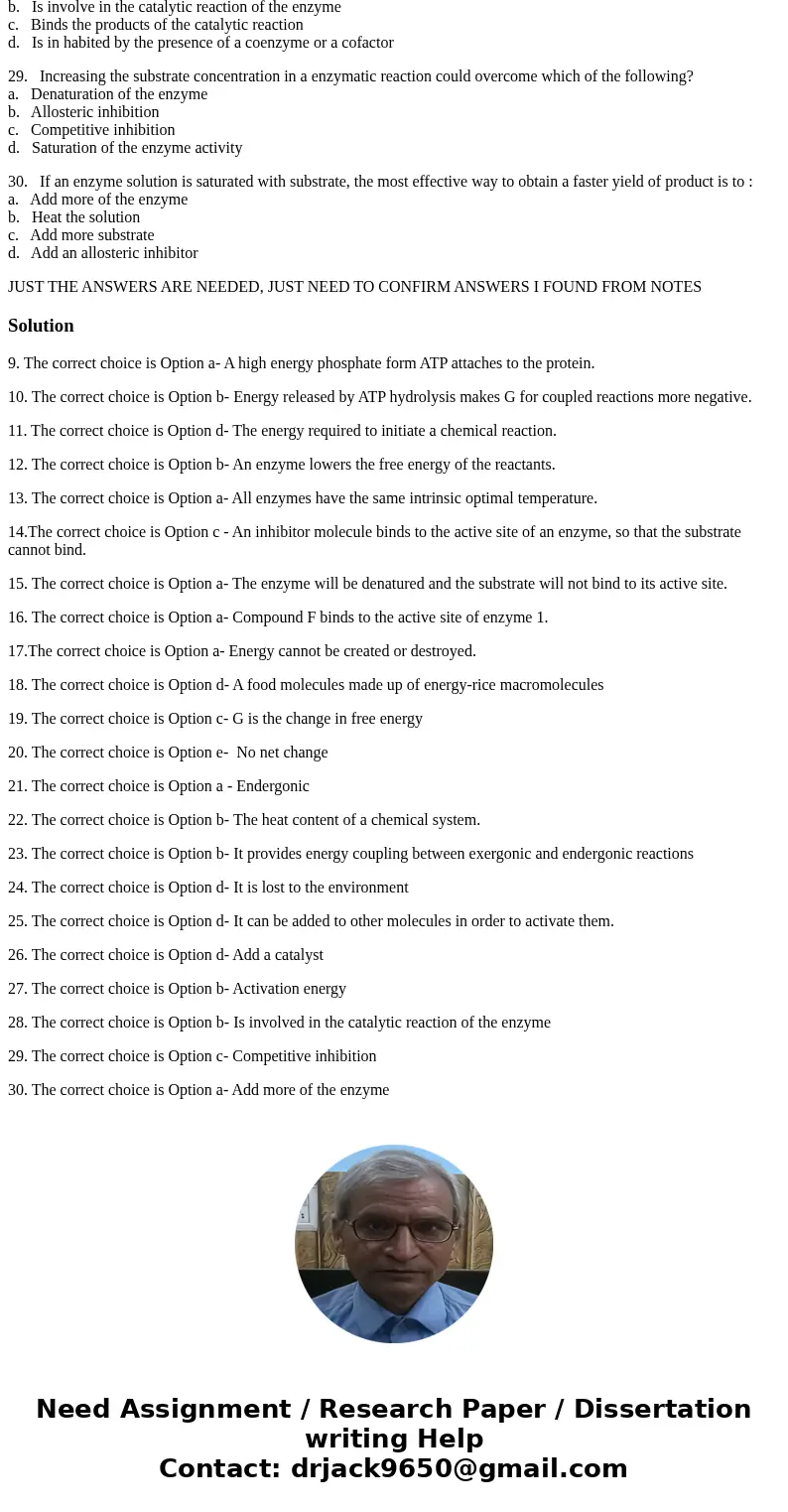9 An in active protein becomes activated by ATP How does ATP
9. An in active protein becomes activated by ATP. How does ATP activate the protein?
a. A high energy phosphate form ATP attaches to the protein
b. ATP is an enzyme
c. ATP removes a phosphate from the protein
d. An ATP molecules binds directly to the protein
10. Cells use ATP to drive endergonic reactions because
a. ATP is a universal catalyst
b. Energy released by ATP hydrolysis makes G for coupled reactions more negative.
c. Energy released by ATP hydrolysis makes G for coupled reactions more positive.
d. The conversion of ATP to ADP is also endergonic.
11. What is activation energy?
a. The thermal energy associated with random movements of molecules
b. The energy released through breaking chemical bonds
c. The difference in free energy between reactants and products
d. The energy required to initiate a chemical reaction
12. Which of the following is not a property of an enzyme?
a. An enzyme reduces the activation energy of a reaction
b. An enzyme lowers the free energy of the reactants
c. An enzyme does not change as a result of the reaction
d. An enzyme works in both the forward and reverse directions of a reaction
13. Which statement about the influence of temperature on enzymes is NOT true?
a. All enzymes have the same intrinsic optimal temperature
b. Raising the temperature may increase the activity of an enzyme
c. Some enzymes are stable at the boiling point of water
d. Raising the temperature may decrease the activity of an enzyme
14. In competitive inhibition
a. Two enzymes compete with each other for a substrate
b. An inhibitor molecule binds to an allosteric site on an enzyme, causing a change in the active site.
c. An inhibitor molecule binds to the active site of an enzyme, so that the substrate cannot bind
d. The products of a reaction both compete for the active site.
15. The enzyme aromatase is found in the cytoplasm of some cells and converts testosterone to estrogen. You decide to test aromatase from a particular cell type, and your lab partner admits that he drastically increased the pH in all the test tubes. Which of the following is a likely result?
a. The enzyme will be denatured and the substrate will not bind to tis active site
b. The enzyme will convert testosterone to estrogen at a faster rate.
c. The mistake will have no effect, as enzymes are not sensitive to changes in ph.
d. The G will be lowered and the reaction will proceed spontaneously.
16. Consider the enzyme-catalyzed pathway below. It is regulated by feedback inhibition of enzyme 1. Which of the following statements is not accurate regarding this pathway?
A->B->C->D->E->F
a) Compound F binds to the active site of enzyme 1
b) Enzyme 1 contains an allosteric site for compound F
c) When enough compound F is made in high enough levels, it shuts off its own synthesis
d) When F binds to enzyme 1, it causes a conformational change
17. Which of the following is a statement of the first law of thermodynamics?
a. Energy cannot be created of destroyed.
b. The entropy of the universe is decreasing.
c. The entropy of the universe is constant.
d. Kinetic energy is stored energy that results from the specific arrangement of matter
e. Energy cannot be transferred or transformed
18. Which of the following is an example of potential rather than kinetic energy?
a. A boy mowing grass
b. Water rushing over Niagara Falls
c. A firefly using light flashes to attract a mate
d. A food molecules made up of energy-rice macromolecules
e. An insect foraging for food
19. The mathematical expression for the change in free energy of a system is G=H -TS. Which of the following is (are) correct?
a. S is the change in enthalpy, a measure of randomness
b. H is the change in entropy, the energy available to do work
c. G is the change in free energy
d. T is the temperature in degrees Celsius
20. What is the change in free energy of a system at chemical equilibrium?
a. Slightly increasing
b. Greatly increasing
c. Slightly decreasing
d. Greatly decreasing
e. No net change
21. A chemical reaction that has a positive G is correctly described as;
a. Endergonic
b. Endothermic
c. Enthalpic
d. Spontaneous
e. Exothermic
22. Which of the following best describe enthalpy (H)?
a. The total kinetic energy of a system
b. The heat content of a chemical system
c. The system’s entropy
d. The cell’s energy equilibrium
e. The condition of a cell that is not able to react.
23. Why is ATP an important molecule in metabolism?
a. Its hydrolysis provides an input of free energy for exergonic reactions
b. It provides energy coupling between exergonic and endergonic reactions
c. Its terminal phosphate group contains a strong covalent bond that when hydrolyzed releases free energy.
d. Its terminal phosphate bond has higher energy than the other two
24. When chemical, transport, or mechanical work is done by an organism, what happens to the heat generated?
a. It is used to power yet more cellular work
b. It is used to store energy as more ATP
c. It is used to generate ADP from nucleotide precursors
d. It is lost to the environment
e. It is transported to specific organs such as the brain.
25. When ATP releases some energy, it also releases inorganic phosphate. What purpose does this serve (of any) to the cell?
a. It is released as excreatory waste
b. It can only be used to regertate more ATP
c. It can be added to water and excreted as liquid
d. It can be added to other molecules in order to activate them.
26. How can one increase the rate of a chemical reaction
a. Increase the activation energy needed
b. Cool the reactants
c. Decrease the concentration of the reactants
d. Add a catalyst
e. Increase the entropy of the reactants
27. Reactants capable of interacting to form products in a chemical reaction must first overcome a thermodynamic barrier known as the reaction;
a. Entropy
b. Activation energy
c. Endothermic level
d. Heat content
e. Free-energy content
28. The active site of an enzyme is the region that
a. Binds allosteric regulators of the enzyme
b. Is involve in the catalytic reaction of the enzyme
c. Binds the products of the catalytic reaction
d. Is in habited by the presence of a coenzyme or a cofactor
29. Increasing the substrate concentration in a enzymatic reaction could overcome which of the following?
a. Denaturation of the enzyme
b. Allosteric inhibition
c. Competitive inhibition
d. Saturation of the enzyme activity
30. If an enzyme solution is saturated with substrate, the most effective way to obtain a faster yield of product is to :
a. Add more of the enzyme
b. Heat the solution
c. Add more substrate
d. Add an allosteric inhibitor
JUST THE ANSWERS ARE NEEDED, JUST NEED TO CONFIRM ANSWERS I FOUND FROM NOTES
Solution
9. The correct choice is Option a- A high energy phosphate form ATP attaches to the protein.
10. The correct choice is Option b- Energy released by ATP hydrolysis makes G for coupled reactions more negative.
11. The correct choice is Option d- The energy required to initiate a chemical reaction.
12. The correct choice is Option b- An enzyme lowers the free energy of the reactants.
13. The correct choice is Option a- All enzymes have the same intrinsic optimal temperature.
14.The correct choice is Option c - An inhibitor molecule binds to the active site of an enzyme, so that the substrate cannot bind.
15. The correct choice is Option a- The enzyme will be denatured and the substrate will not bind to its active site.
16. The correct choice is Option a- Compound F binds to the active site of enzyme 1.
17.The correct choice is Option a- Energy cannot be created or destroyed.
18. The correct choice is Option d- A food molecules made up of energy-rice macromolecules
19. The correct choice is Option c- G is the change in free energy
20. The correct choice is Option e- No net change
21. The correct choice is Option a - Endergonic
22. The correct choice is Option b- The heat content of a chemical system.
23. The correct choice is Option b- It provides energy coupling between exergonic and endergonic reactions
24. The correct choice is Option d- It is lost to the environment
25. The correct choice is Option d- It can be added to other molecules in order to activate them.
26. The correct choice is Option d- Add a catalyst
27. The correct choice is Option b- Activation energy
28. The correct choice is Option b- Is involved in the catalytic reaction of the enzyme
29. The correct choice is Option c- Competitive inhibition
30. The correct choice is Option a- Add more of the enzyme




 Homework Sourse
Homework Sourse